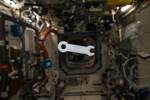International Space Station Now 3D Printing with PEI/PC Materials
PEI/PC compound is the third material a developer of zero-gravity 3D printers has demonstrated on the International Space Station for space-based additive manufacturing.
U.S.-based Made In Space, a developer of zero-gravity 3D printers and an official supplier to NASA, recently announced it has begun using PEI/PC (polyetherimide/polycarbonate) blends, a high-performance alloy, for 3D printing in its Additive Manufacturing Facility (AMF) aboard the International Space Station (ISS). PEI/PC is an aerospace-grade polymer that produces stronger, more heat-resistant materials. Blends of PEI/PC, such as ULTEM 9085 and ULTEM 1010, are used in additive manufacturing in the commercial aerospace industry.
“Made In Space is proud to add PEI/PC to the suite of materials it is manufacturing in space with,” MIS President & CEO Andrew Rush said. “Our team has been regularly printing parts in space with AMF for over a year now. This unparalleled knowledge base of in-space manufacturing operations will enable us to deliver future in-space manufacturing solutions in the most cost effective and efficient ways possible.”
Last year, I reported that MIS worked with Braskem to produce green PE specifically for 3D printing in zero gravity. The technology allows astronauts to fabricate tools and spare parts in space using the biobased resin.
Terrestrially, PEI/PC is used in aircraft cabins and in the medical industry. Having nearly triple the tensile strength of ABS, a high strength-to-weight ratio and low off-gassing properties, PEI/PC has been used in space on external hardware and satellites. According to Rush:
“Manufacturing in PEI/PC really expands the value of in-space manufacturing for human spaceflight. PEI/PC is a truly space-capable material. With it, extra-vehicular activity (EVA) tools and repairs, stronger and more capable intra-vehicular activity (IVA) tools, spares, and repairs, and even satellite structure can be created on site, on demand. That enables safer, less mass-intensive missions and scientific experiments.”
Up Next: Making Parts for Space, In Space
One program PEI/PC will benefit is the Archinaut Development Program, which MIS has contracted with NASA on. Archinaut is a platform that manufactures, assembles, and integrates space-optimized systems. These systems include reflectors, antennae, trusses, booms, and radiators. Archinaut is specifically designed to create large structures for space, in space. In its basic configuration, Archinaut is a system integrated into a satellite and includes a space-capable manufacturing unit, assembly robotics, feedstock, and prefabricated components. Once in orbit, space-optimized structures are manufactured and integrated into the satellite which can be larger, more capable, and/or lighter than traditional deployables can achieve.
Archinaut is specifically designed to create large structures for space, in space.
Related Content
-
The Connector Conundrum: 3D Printed Mold Tooling’s Role in Innovation
ReelView Fishing faced an electronics obstacle in the development of its new technology for underwater video. Additive manufacturing for moldmaking allowed for the speed necessary to iterate to a solution. How inventors and invention will benefit from new ways of obtaining production-ready tooling.
-
NPE 2024: Additive Manufacturing Assisting, Advancing Plastics Processing
Exhibitors and presenters at the plastics show emphasized 3D printing as a complement and aid to more traditional production processes.
-
3D Printing of Injection Molds Flows in a New Direction
Hybrids of additive manufacturing and CNC machining can shorten tooling turnaround times.
















